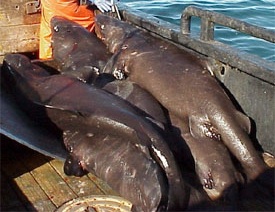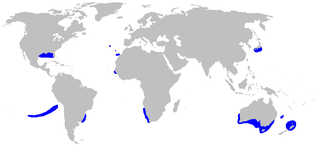
The Squaliformes are an order of sharks that includes about 126 species in seven families.
The Centrophoridae are a family of squaliform sharks. The family contains just two genera and about 15 species. They are sometimes called gulper sharks, but this is also the name of a specific species in the family, Centrophorus granulosus. These are generally deepwater fish. While some, such as the gulper shark C. granulosus, are found worldwide and fished commercially, others are uncommon and little-known. Their usual prey is other fish; some are known to feed on squid, octopus, and shrimp. Some species live on the bottom (benthic), while others are pelagic. They are ovoviviparous, with the female retaining the egg-cases in her body until they hatch.

The Pacific sleeper shark is a sleeper shark of the family Somniosidae, measuring up to 4.4 m (14 ft) in length, although it could possibly reach lengths in excess of 7 m (23 ft). It is found in the Pacific Ocean, usually in the northern hemisphere, but observations in recent years show it is also present in the southern hemisphere.

The Greenland shark, also known as the gurry shark or grey shark, is a large shark of the family Somniosidae, closely related to the Pacific and southern sleeper sharks. Inhabiting the North Atlantic and Arctic Oceans, they are notable for their exceptional longevity, although they are poorly studied due to the depth and remoteness of their natural habitat.
Centrophorus is a genus of squaliform sharks. These deep-water sharks, found in temperate and tropical oceans throughout the world, are characterized by grey or brown bodies, large green eyes, and spines on both dorsal fins. These spines give them their name, from Greek κεντρον, kentron meaning "thorn" and φέρειν, pherein meaning "to bear".

The longnose velvet dogfish is a sleeper shark of the family Somniosidae, found circumglobally in southern hemisphere subtropical seas, at depths of between 230 and 1,500 m. It reaches a length of 130 cm. It has a diet consisting of predominantly mesopelagic fishes and squids.

The roughskin dogfish is a sleeper shark of the family Somniosidae, found around the world on continental shelves in tropical, subtropical and temperate seas, at depths of between 100 and 1,500 m. It reaches a length of 121 cm.

The mandarin dogfish is a dogfish, a member of the family Squalidae in the order Squaliformes. It is found at depths of 140–650 metres (460–2,130 ft) off southern Japan, Taiwan, and Indonesia. Populations off Australia and New Zealand were formerly included in this species, but in 2007 these were assigned to a new species, the southern mandarin dogfish. It is not clear which of these species is involved in other populations from the tropical West Pacific.

Somniosus is a widely distributed genus of deepwater dogfish sharks in the family Somniosidae. Several members of the genus are believed to attain lengths up to 7 m (23 ft), thus ranking among the largest of sharks.

The Portuguese dogfish or Portuguese shark, is a species of sleeper shark of the family Somniosidae. This globally distributed species has been reported down to a depth of 3,675 m (12,057 ft), making it the deepest-living shark known. It inhabits lower continental slopes and abyssal plains, usually staying near the bottom. Stocky and dark brown in color, the Portuguese dogfish can be distinguished from similar-looking species by the small spines in front of its dorsal fins. Its dermal denticles are also unusual, resembling the scales of a bony fish. This species typically reaches 0.9–1 m (3.0–3.3 ft) in length; sharks in the Mediterranean Sea are much smaller and have distinct depth and food preferences.
Centroscymnus is a genus of squaliform sleeper sharks in the family Somniosidae and of the phylum chordata.
Scymnodon is a genus of squaliform sharks in the family Somniosidae.

The Japanese velvet dogfish is a harmless deepwater sleeper shark of the family Somniosidae, found in the northwest Pacific from Suruga Bay and adjacent waters of Japan at depths of between 500 and 800 metres. Reproduction is ovoviviparous.

The velvet dogfish, the only member of the genus Zameus, is a small sleeper shark of the family Somniosidae, found around the world between latitudes 64°N and 48°S, from the surface to 2,000 m.

The southern sleeper shark, or Whitley's sleeper shark, is a deepwater benthopelagic sleeper shark of the family Somniosidae found in the southern and subantarctic extremes of the Atlantic, Indian and Pacific Oceans, and some northern reaches of the Antarctic oceans. It has been recorded near the southernmost areas of South America, near South Africa, southern Australia, Tasmania and New Zealand, as well as more remote locations in the south-central Indian Ocean.














